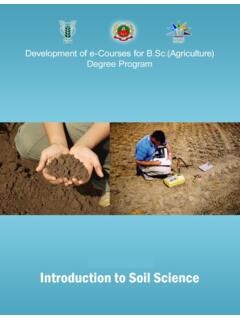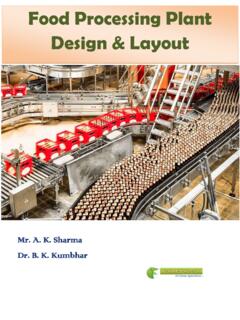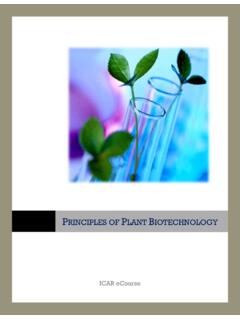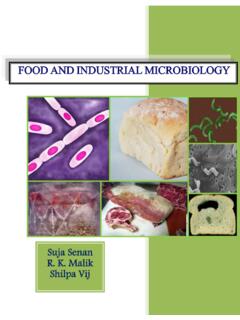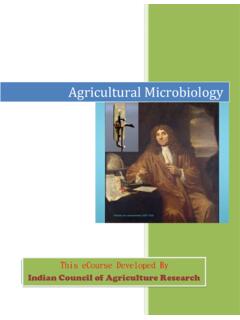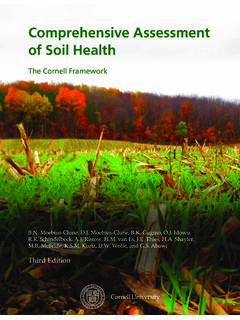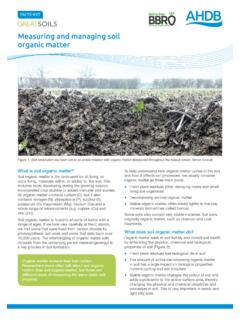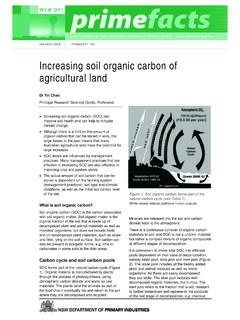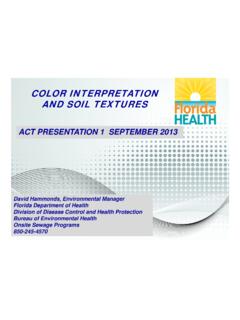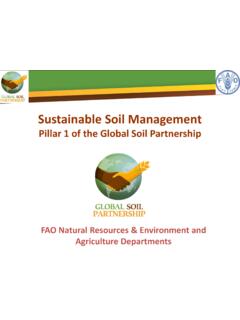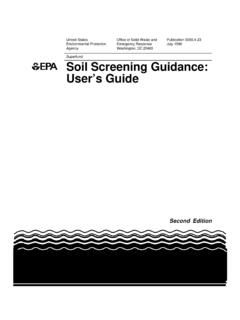Transcription of Soil Chemistry, Soil Fertility & Nutrient Management
1 soil chemistry , soil Fertility & Nutrient Management ICAR e-Course For (Agriculture) and (Agriculture). Index SN Lecture Page No 1. soil chemistry 1-2. 2. soil pH and Buffer pH 3-6. 3. soil pH and Percent Base Saturation 7-9. 4. soil as a source of plant nutrients - Essential and beneficial elements, 10-15. criteria of essentiality 5. Forms of nutrients in soil and their functions in plants 16-25. 6. Mechanism of Nutrient transport in plants 26-29. 7. Nitrogen Transformation, factors affecting nitrogen availability 30-39. ,deficiency and toxicity symptoms 8. Phosphorus Transformation, factors affecting Phosphorus 40-48. availability, deficiency and toxicity symptoms 9. Potassium Transformation, factors affecting Potassium availability, 49-52. deficiency and toxicity symptoms 10. Secondary nutrients Transformation, factors affecting Nutrient 53-59.
2 Availability, deficiency and toxicity symptoms 11. Micro nutrients Transformation, factors affecting Nutrient 60-76. availability, deficiency and toxicity symptoms 12. Nutrient Deficiency and Toxicity 77-83. 13. soil Fertility Evaluation 84-89. 14. Predicting Yields using Nutrient Functions 90-95. 15. Fertility Evaluation By Plant Analysis 96-102. 16. soil Testing and Correlation 103-105. 17. soil Testing 106-111. 18. Fertility Survey and Mapping 112-114. 19. Permanent Manorial Experiments 115-117. 20. Fertilizers Use and Legislation 118-124. 21. Prospects of Fertilizer Use 125-128. 22. Tolerance limit in Plant Nutrient for various fertilizers 129-134. 23. Genesis, Characteristics, and Reclamation of acid soils 135-142. 24. Genesis, Characteristics, and Reclamation of saline soils 143-146.
3 25. Genesis, Characteristics, and Reclamation of sodic soils 147-153. 26. Characteristics and Remediation of heavy metal contaminated soils 154-156. 27. Assessment of Irrigation Water Quality 157-166. soil chemistry , soil Fertility & Nutrient Management LECTURE 1 soil chemistry Until the late 1960s, soil chemistry focused primarily on chemical reactions in the soil that contribute to pedogenesis or that affect plant growth. Since then concerns have grown about environmental pollution, organic and inorganic soil contamination and potential ecological health and environmental health risks. Consequently, the emphasis in soil chemistry has shifted from pedology and agricultural soil science to an emphasis on environmental soil science. A knowledge of environmental soil chemistry is paramount to predicting the fate, mobility and potential toxicity of contaminants in the environment.
4 The vast majority of environmental contaminants are initially released to the soil . Once a chemical is exposed to the soil environment a myriad of chemical reactions can occur that may increase/decrease contaminant toxicity. These reactions include adsorption/desorption, precipitation, polymerization, dissolution, complexation, and oxidation/reduction. These reactions are often disregarded by scientists and engineers involved with environmental remediation. Understanding these processes enable us to better predict the fate and toxicity of contaminants and provide the knowledge to develop scientifically correct, and cost-effective remediation strategies. Reduction potential (also known as redox potential) is the tendency of a chemical species to acquire electrons and thereby be reduced.
5 Each species has its own intrinsic reduction potential; the more positive the potential, the greater the species' affinity for electrons and tendency to be reduced. A reduction potential is measured in volts (V). Because the true or absolute potentials are difficult to accurately measure, reduction potentials are defined relative to the standard hydrogen electrode (SHE) which is arbitrarily given a potential of volts. Standard reduction potential (E0), is measured under standard conditions: 25 C, a 1M concentration for each ion participating in the 1 soil chemistry , soil Fertility & Nutrient Management reaction, a partial pressure of 1 atm for each gas that is part of the reaction, and metals in their pure state. Historically, many countries, including the United States, used standard oxidation potentials rather than reduction potentials in their calculations.
6 These are simply the negative of standard reduction potentials, so it is not a major problem in practice. However, because these can also be referred to as "redox potentials", the terms "reduction potentials" and "oxidation potentials" are preferred by the IUPAC. The two may be explicitly distinguished in symbols as Er0 and Eo0. The relative reactivities of different half-cells can be compared to predict the direction of electron flow. A higher E0 means there is a greater tendency for reduction to occur, while a lower one means there is a greater tendency for oxidation to occur. Any system or environment that accepts electrons from a normal hydrogen electrode is a half cell that is defined as having a positive redox potential; any system donating electrons to the hydrogen electrode is defined as having a negative redox potential.
7 Eh is measured in millivolts (mV). A high positive Eh indicates an environment that favors oxidation reaction such as free oxygen. A. low negative Eh indicates a strong reducing environment, such as free metals. Sometimes when electrolysis is carried out in an aqueous solution, water, rather than the solute, is oxidized or reduced. For example, if an aqueous solution of NaCl is electrolyzed, water may be reduced at the cathode to produce H2(g) and OH- ions, instead of Na+ being reduced to Na(s), as occurs in the absence of water. It is the reduction potential of each species present that will determine which species will be oxidized or reduced. Absolute reduction potentials can be determined if we find the actual potential between electrode and electrolyte for any one reaction. Surface polarization interferes with measurements, but various sources give an estimated potential for the standard hydrogen electrode of to (the electrolyte being positive.)
8 2 soil chemistry , soil Fertility & Nutrient Management LECTURE 2 soil pH and Buffer pH. soil pH This is a measure of the soil acidity or alkalinity and is sometimes called the soil "water" pH. This is because it is a measure of the pH of the soil solution, which is considered the active pH that affects plant growth. soil pH is the foundation of essentially all soil chemistry and Nutrient reaction and should be the first consideration when evaluating a soil test. The total range of the pH scale is from 0 to 14. Values below the mid-point (pH ) are acidic and those above pH. are alkaline. A soil pH of is considered to be neutral. Most plants perform best in a soil that is slightly acid to neutral (pH to ). Some plants like blueberries require the soil to be more acid (pH to ), and others, like alfalfa will tolerate a slightly alkaline soil (pH ).
9 The soil pH scale is logarithmic, meaning that each whole number is a factor of 10 larger or smaller than the ones next to it. For example if a soil has a pH of and this pH is lowered to pH , the acid content of that soil is increased 10-fold. If the pH is lowered further to pH , the acid content becomes 100 times greater than at pH The logarithmic nature of the pH scale means that small changes in a soil pH can have large effects on Nutrient availability and plant growth. Buffer pH (BpH) This is a value that is generated in the laboratory, it is not an existing feature of the soil . Laboratories perform this test in order to develop lime recommendations, and it actually has no other practical value. In basic terms, the BpH is the resulting sample pH after the laboratory has added a liming material.
10 In this test, the laboratory adds a chemical mixture called a buffering solution. This solution functions like extremely fast-acting lime. Each soil sample receives the same amount of buffering solution; therefore the resulting pH is different for each sample. To determine a lime recommendation, 3 soil chemistry , soil Fertility & Nutrient Management the laboratory looks at the difference between the original soil pH and the ending pH after the buffering solution has reacted with the soil . If the difference between the two pH measurements is large, it means that the soil pH is easily changed, and a low rate of lime will suffice. If the soil pH changes only a little after the buffering solution has reacted, it means that the soil pH is difficult to change and a larger lime addition is needed to reach the desired pH for the crop.
